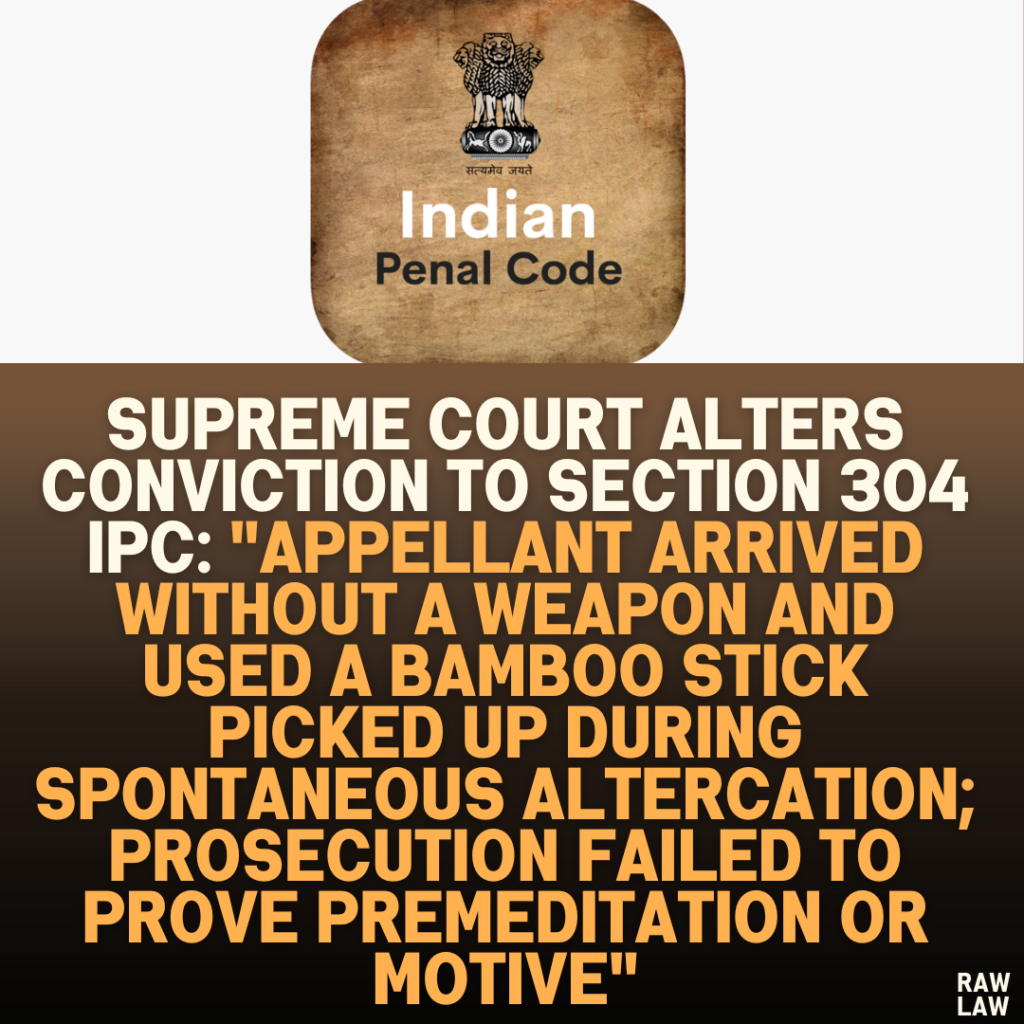Court’s Decision
The Supreme Court, in its judgment dated November 20, 2024, altered the appellant’s conviction from Section 302 IPC (murder) to Section 304 Part I IPC (culpable homicide not amounting to murder). It held that the prosecution failed to establish evidence of premeditation or motive, which is essential for a conviction under Section 302 IPC. The Court observed:
“The prosecution has utterly failed to prove any case of premeditation. The weapon used is a bamboo stick, commonly available in a village, and the nature of injuries does not indicate any undue advantage or cruel manner of assault.”
Since the appellant had already served over 12 years (including remission), the Court sentenced him to the period already undergone and discharged any bail bonds.
Facts
- Incident Background:
- On March 21, 2014, the deceased and his wife visited the house of a relative (PW-5). During their stay, the appellant arrived and began abusing the host couple over a financial dispute.
- The deceased intervened, attempting to pacify the appellant and suggested resolving the grievance the next day.
- Sequence of Events:
- The appellant left the premises but continued to hurl abuses and provoked the deceased to step outside.
- The deceased followed the appellant, leading to an altercation near the Khadkoba Temple road.
- The appellant assaulted the deceased with a bamboo stick, causing severe injuries, primarily to the head and face. Witnesses arrived to see the appellant fleeing the scene.
- Death and Investigation:
- The deceased was taken to the Rural Hospital, Khandala, where he was declared dead.
- An FIR was registered against the appellant under Sections 302 (murder) and 504 (intentional insult to provoke breach of peace) IPC.
- The appellant was arrested, and a bamboo stick was recovered based on his disclosure statement. The case proceeded to trial.
- Trial and Appeals:
- The trial court convicted the appellant under Section 302 IPC, sentencing him to life imprisonment. This decision was upheld by the High Court.
- The appellant challenged the High Court’s judgment in the Supreme Court.
Issues
- Whether the appellant’s conviction under Section 302 IPC was legally sustainable given the evidence on record.
- Whether the facts and circumstances supported a reduction in the conviction to culpable homicide under Section 304 IPC.
Petitioner’s Arguments
- Contradictions in Evidence:
- The appellant argued that the prosecution’s witnesses provided inconsistent and contradictory statements, particularly between the FIR and their depositions in court.
- The evidence did not conclusively establish the sequence of events or the appellant’s role.
- Sudden Provocation:
- The defense claimed that the incident arose out of a sudden and grave provocation during an unplanned altercation, which did not warrant a murder conviction.
- The absence of premeditation and the use of a bamboo stick (a common object) pointed to a lesser offence.
Respondent’s Arguments
- Consistency in Testimonies:
- The prosecution argued that the testimonies of key witnesses were consistent and corroborated the appellant’s role in the assault.
- Eyewitnesses clearly identified the appellant as the assailant.
- Supporting Evidence:
- The circumstantial evidence, including the recovery of the bamboo stick and the appellant’s blood-stained clothes, corroborated the prosecution’s case.
- The respondent maintained that the concurrent findings of the trial and High Court justified the conviction under Section 302 IPC.
Analysis of the Law
- Premeditation and Motive:
- The Court emphasized the lack of evidence to establish any motive or premeditation for the murder.
- It reiterated the principle that a conviction under Section 302 IPC requires a clear intention to kill or knowledge that the act would likely cause death.
- Nature of the Weapon:
- The bamboo stick, an object commonly available in villages, indicated the absence of a planned assault.
- The medical evidence did not suggest that the injuries were inflicted in a cruel or unusual manner.
- Sequence of Events:
- The deceased had followed the appellant after the initial altercation. The prosecution failed to provide a coherent account of what transpired before the assault.
- Culpable Homicide vs. Murder:
- The Court distinguished between murder and culpable homicide, focusing on the absence of intent and the sudden nature of the quarrel.
Precedent Analysis
The Court applied principles from previous rulings that emphasized:
- The necessity of proving premeditation for a murder conviction.
- Instances where sudden provocation and the use of a common object during an unplanned altercation justified a conviction under Section 304 IPC instead of Section 302 IPC.
Court’s Reasoning
- Prosecution’s Failure to Prove Premeditation:
- The appellant arrived at the scene without a weapon and used a bamboo stick picked up during the altercation.
- The absence of a motive further weakened the prosecution’s case.
- Heat of Passion:
- The altercation occurred spontaneously after the deceased followed the appellant. This sequence of events pointed to a lack of intent to kill.
- Appropriate Conviction:
- The appellant’s actions fit within the scope of culpable homicide not amounting to murder under Section 304 Part I IPC.
Conclusion
- The Supreme Court altered the appellant’s conviction to Section 304 Part I IPC.
- Since the appellant had already served over 12 years, the sentence was reduced to the period already undergone.
- The bail bonds were discharged.
Implications
- Clarification on Premeditation:
- The judgment reaffirms the need for the prosecution to establish motive and premeditation for a conviction under Section 302 IPC.
- It underscores that spontaneous altercations without clear intent to kill fall under culpable homicide.
- Judicial Discretion in Sentencing:
- The Court’s decision highlights the importance of considering mitigating factors, such as the nature of the weapon, the sequence of events, and the absence of cruelty.




Pingback: Kerala High Court Directs Registration of Unregistered Sale Deed for 213.27 Hectares of Land Despite Pending Special Leave Petition Before Supreme Court, Subject to Final Outcome - Raw Law